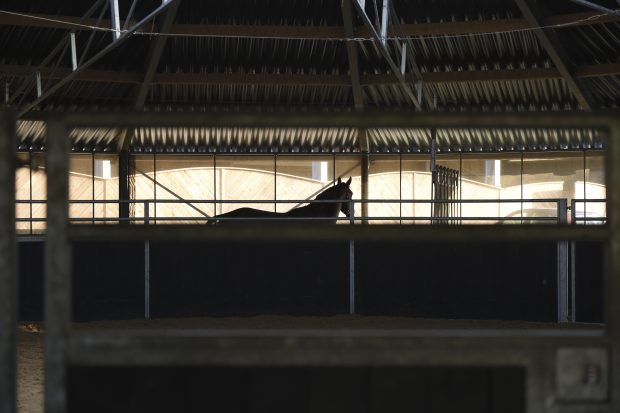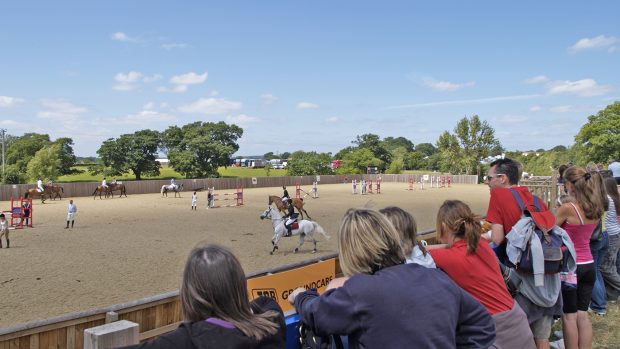Dr David Marlin, chairman of the 2006 International Conference on Equine Exercise Physiology (ICEEP), defines exercise physiology as “the study of all the systems used in exercise”.
Dr Marlin, an equine exercise specialist whose posts include sports science consultant to the British Equestrian Federation and head of higher education at The Open College of Equine Studies (TOCES), says that exercise physiology is having an increasingly greater impact on all disciplines, but in particular on racing and endurance
“We want to see it used to benefit horse health, welfare and performance,” he stresses. “If it improves health and welfare and at the same time helps horses run faster or perform better, that’s great. But when aiming for increased performance, health and welfare must be paramount.”
At the first TOCES science conference in October, Dr Marlin highlighted some of the latest findings from around the world, many of which are linked to research in human sports.
Can inflatable cuffs boost muscle response to training?
The cuffs featured in a Japanese study based on KAATSU (an acronym for a Japanese phrase meaning increased pressure training). A group of Standardbred mares was trained at walk, once a day, six days a week over two weeks; half wore KAATSU cuffs and the other half acted as a control and were walked without them.
The cuffs are inflated to above arterial pressure, which restricts the blood flow to muscles and increases the response to training. Measurements of muscles and tendons taken before and after the two-week training period showed an increase in muscle thickness of about 11% in horses wearing cuffs, with no difference in the tendons.
“We don’t know yet whether this is beneficial, but there is definitely room for more studies,” says Dr Marlin.
How fast do horses lose fitness if they are taken out of training?
Dr Marlin says some trainers might pull a horse out of a race if it missed even a couple of days’ training because of fears that it might have lost fitness — but, from a scientific point of view, these fears may be groundless.
In another Japanese study, horses were trained for six months, then spent 10 weeks out of training, in the field. Measuring their oxygen capacity before and afterwards showed that they maintained their aerobic capacity.
“They lost weight when trained and put it on when out of training, but that’s diet-related,” says Dr Marlin. “The interesting thing is that some of us have been saying for years that once a horse is fit, it doesn’t lose that fitness quickly — and obviously, the less wear and tear you put on horses, the better it is.
“I believe you can get any horse physically fit — though not necessarily from the skills point of view — in about 16 weeks. Once you’ve got them there, you don’t need to keep training, and if you do, you’re just imposing more wear and tear: this is something of which riders in all disciplines must be aware.”
What is needed now, says Dr Marlin, is trainers brave enough to try it. He believes some would be reluctant to alter their regime through reluctance to take such a perceived risk of losing current performance.
“You need someone like [national hunt trainer] Martin Pipe, who was brave enough to try things,” he says.
How long does it take young racehorses to adapt to bone stress in training?
We know the third metacarpal bone thickens in response to fast exercise, but an Australian study gave a clearer picture. Researchers looked at 40 horses who started training at ages between 20 months and 31/2 years, X-rayed their cannon bones and looked for a plateau in bone thickness. On average, it took 501 days — but one horse took 21/2 years to adapt.
“One horse in the study increased bone mass in the cannon bone by around 30% over 600 days,” says Dr Marlin. “Some of this is likely due to growth, not just work, but it may be that starting slower training earlier would allow bone to be thicker and become better adapted before the horse goes into fast training.”
Can maximum heartrate be equated with age in horses, as it is in people?
Human athletes using heartrate monitors in training work to the equation that their maximum heartrate — colloquially called heartrate max — should be 220 minus age, so the heartrate max for an 18-year-old would be 202 beats per minute, and for a 60-year-old, 160bpm.
It was found that with horses, heartrate increased in a linear fashion until about 220bpm, then reached a plateau. The state of fitness and gender had slight effects, with mares reaching 228bpm and stallions and geldings 225bpm, but they were so slight as to be of little significance.
So you can use the same equation for your horse as yourself when training — but, warns Dr Marlin, remember that if you work a young horse at 200bpm and then work a 15-year-old to the same heartrate, you will actually be working the older horse harder.
How much effort does it take to jump?
A Dutch study looked at horses jumping a 700m course of 12 fences between 0.8m and 1m and compared their heartrates during jumping with those going round the same track with the poles taken out. As a control measure, half the horses went round with the poles out and then jumped and the other half performed the elements of the exercise the other way round.
The difference in heartrates, which went up to more than 180bpm, showed that jumping required about 20% more effort.
“You might say that it’s no surprise that jumping is harder work than cantering on the flat,” acknowledges Dr Marlin. “But now we know how much harder, at least at this level — until now, we have known how much effort it takes for a horse to walk, trot and canter, but didn’t know how much it took to jump.
“Research often provides as many questions as it does answers. The skill is in working out what are the implications of the research and applying them.”




